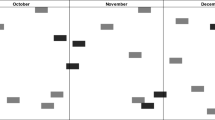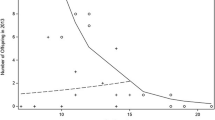Abstract
Reproductive physiology was studied in female stumptail macaques. Initially the monkeys were housed indoors (individually and in small groups) and later as one large (92 individuals) social group in an outdoor cage. Most data were collected during the 4-year outdoor period. Plasma progesterone determination in blood samples taken at weekly intervals allowed estimation of ovulation and conception dates. The age at first ovulation (X =3.73 years) was positively correlated with body weight at 3 years of age. The average age at first birth was 4.90 years. Gestation lengths averaged 176.6 days. Following a live birth ovulations returned after a mean interval of 11 months but following an abortion or still birth this interval was 1 month. Usually a number of ovulatory cycles (X =2.37) preceded a conception. Interbirth intervals (IBIs) in the outdoor cage (X =619.4 days) were significantly longer than IBIs during the indoor period (X =523.1), because indoors the infants were weaned at the age of 7 months, while outdoors weaning occurred more naturally. IBIs following abortions or still births (X =291.9 days) were significantly shorter than IBIs following live births. Age at first ovulation, age at first birth, IBIs, and infant production rates were not correlated with dominance rank. Ovarian cycle lengths (X =30.2 days, mode = 28 days) were comparable to previously reported data from laboratory-housed stumptails. No systematic seasonal fluctuations were found in the onset of sexual maturity, in ovarian cycle lengths, in copulation frequencies, and in distribution of births.
Similar content being viewed by others
References
Abbott, D. H., and Hearn, J. P. (1978). Physical, hormonal and behavioural aspects of sexual development in the marmoset monkey,Callithrix jacchus. J. Reprod. Fert. 53: 155–166.
Abbott, D. H., McNeilly, A. S., Lunn, S. F., Hulme, M. J., and Burden, F. J. (1981). Inhibition of ovarian function in subordinate female marmoset monkeys (Callithrix jacchus jacchus).J. Reprod. Fert. 63: 335–345.
Altmann, J., Altmann, S. A., and Hausfater, G. (1978). Primate infant’s effects on mother’s future reproduction.Science 201: 1028–1029.
Bertrand, M. (1969). The behavioral repertoire of the stumptail macaque: A descriptive and comparative study.Bibl. Primatol. 11: 1–273.
Bielert, C., and Vandenbergh, J. G. (1981). Seasonal influences on birth and male sex skin coloration in rhesus monkeys (Macaca mulatto) in the southern hemisphere.J. Reprod. Fert. 62: 229–233.
Brueggemann, S., and Dukelow, W. R. (1980). Characteristics of the menstrual cycle in nonhuman primates. III. Timed matingm inMacaca arctoides.J. Med. Primatol. 9: 213–221.
Burton, F. D., and Sawchuk, L. A. (1982). Birth intervals inM. sylvanus of Gibraltar.Primates 23: 140–144.
Coe, C. L., Connolly, A. C., Kraemer, H. C., and Levine, S. (1979). Reproductive development and behavior of captive female chimpanzees.Primates 20: 571–582.
Coe, C. L., Chen, J., Lowe, E. L., Davidson, J. M., and Levine, S. (1981). Hormonal and behavioral changes at puberty in the squirrel monkey.Horm. Behav. 15: 36–53.
Crockett, C. M., and Wilson, W. L. (1980). The ecological separationof Macaca nemestrina andM. fascicularis in Sumatra. In Lindburg, D.G. (ed.),The Macaques. Studies in Ecology, Behavior and Evolution, Van Nostrand Reinhold, New York, pp. 148–181.
Dittus, W. P. J. (1979). The evolution of behaviours regulating density and age-specific sex ratios in a primate population.Behaviour 69: 265–302.
Dixson, A. F. (1977). Observations on the displays, menstrual cycles and sexual behaviour of the “Black ape” of Celebes (Macaca nigra).J. Zool. (Lond.) 182: 63–84.
Doering, G. K. (1969). The incidence of anovular cycles in women.J. Reprod. Fert. Suppl. 6: 77–81.
Drickamer, L. C. (1974). A ten-year summary of reproductive data for free-rangingMacaca mulatto.Folia primatol. 21: 61–80.
Dukelow, W. R., Grauwiler, J., and Brueggemann, S. (1979). Characteristics of the menstrual cycle in nonhuman primates. I. Similarities and dissimilarities betweenMacaca fascicularis andMacaca arctoides. J. Med. Primatol. 8: 39–47.
Dunbar, R. I. M., and Dunbar, E. P. (1977). Dominance and reproductive success among female gelada baboons.Nature (Lond.) 266: 351–352.
Estrada, A., and Estrada, R. (1976). Birth and breeding cyclicity in an outdoor living stumptail macaque (Macaca arctoides) group.Primates 17: 225–231.
Estrada, A., and Estrada, R. (1981). Reproductive seasonality in a free-ranging troop of stumptail macaques (Macaca arctoides): A five-year report.Primates 22: 503–511.
Fooden, J. (1975). Taxonomy and evolution of liontail and pigtail macaques (Primates: Cercopithecidae).Field. Zool. 67: 1–169.
Frisch, R. E., and Revelle, R. (1970). Height and weight at menarche and a hypothesis of critical body weights and adolescent events.Science 169: 397–398.
Furuya, Y. (1965). Social organization of the crab-eating monkey.Primates 6: 285–336.
Goldfoot, D. A., Slob, A. K., Scheffler, G., Robinson, J. A., Wiegand, S. J., and Cords, J. (1975). Multiple ejaculations during prolonged sexual tests and lack of resultant serum testosterone increases in male stumptail macaqus (M. arctoides). Arch. Sex. Behav. 4: 547–560.
Gordon, T. P. (1981). Reproductive behavior in the rhesus monkey: Social and endocrine variables.Am. Zool. 21: 185–195.
Gouzoules, H., Gouzoules, S., and Fedigan, L. (1982). Behavioural dominance and reproductive success in female Japanese monkeys (Macaca fuscata). Anim. Behav. 30: 1138–1150.
Hadidian, J., and Bernstein, I. S. (1979). Female reproductive cycles and birth data from an Old World monkey colony.Primates 20: 429–442.
Hanby, J. P., Robertson, L. T., and Phoenix, C. H. (1971). The sexual behavior of a confined troop of Japanese macaques.Folia primatol. 16: 123–143.
Hartman, C. G. (1931). On the relative sterility of the adolescent organism.Science 74: 226–227.
Howie, P. W., McNeilly, A. S., Houston, M. J., Cook, A., and Boyle, H. (1982a). Fertility after childbirth: Infant feeding patterns, basal PRL levels and post-partum ovulation.Clin. Endocrinol. 17: 315–322.
Howie, P. W., McNeily, A. S., Houston, M. J., Cook, A., and Boyle, H. (1982b). Fertility after childbirth: Post-partum ovulation and menstruation in bottle and breast feeding mothers.Clin. Endocrinol. 17: 323–332.
Kawai, M., Azuma, S., and Yoshiba, K. (1967). Ecological studies of reproduction in Japanese monkeys (Macaca fuscata). Problems of the birth season.Primates 8: 35–74.
Kirk, R. E. (1968).Experimental Design: Procedures for the Behavioral Sciences, Brooks/Cole, Belmont.
Koford, C. B. (1965). Population dynamics of rhesus monkeys on Cayo Santiago. In DeVore, I. (ed.),Primate Behavior: Field Studies of Monkeys and Apes, Holt, Rinehart & Winston, New York, pp. 160–174.
Koninckx, P. R., deMoor, P., and Brosens, I. A. (1980). Diagnosis of the luteinized unruptured follicle syndrome by steroid hormone assays on peritoneal fluid.Br. J. Obstet. Gynecol. 87: 929–934.
Koninckx, P. R., Brosens, I. A., Verhoeven, G., and de Moor, P. (1981). Increased postovulatory plasma follicle stimulating hormone levels in the luteinized unruptured follicle syndrome: A role for inhibin?Br. J. Obstet. Gynecol. 88: 525–529.
Lancaster, J. B., and Lee, R. B. (1965). The annual reproductive cycle in monkeys and apes. In DeVore, I. (ed.),Primate Behavior: Field Studies of Monkeys and Apes, Holt, Rinehart & Winston, New York, pp. 486–513.
MacDonald, G. J. (1971). Reproductive patterns of three species of macaques.Fert. Ster. 22: 373–377.
MacRoberts, M. H., and MacRoberts, B. R. (1966). The annual reproductive cycle of the Barbary ape (Macaca sylvana) in Gibraltar.Am. J. Phys. Anthropol. 25: 299–304.
Maple, T., Erwin, J., and Mitchell, G. (1973). Age of sexual maturity in laboratory-born pairs of rhesus monkeys (Macaca mulatto). Primates 14: 427–428.
McCann, C. (1933). Notes on some Indian macaques.J. Bombay Nat. Hist. Soc. 36: 796–810.
McNeilly, A. S. (1979). Effects of lactation on fertility.Br. Med. Bull. 35: 151–154.
McNeilly, A. S., Glasier, A., Jonassen, J., and Howie, P. W. (1982). Evidence for direct inhibition of ovarian function by prolactin.J. Reprod. Fert. 65: 559–569.
Meijs-Roelofs, H. M. A., Greef, W. J. de, and Uilenbroek, J. Th. J. (1975). Plasma progesterone and its relationship to serum gonadotrophins in immature female rats.J. Endocrinol. 64: 329–336.
Mori, A. (1979). Analysis of population changes by measurement of body weight in the Koshima troop of Japanese monkeys.Primates 20: 371–397.
Nigi, H. (1976). Some aspects related to conception of the Japanese monkey (Macaca fuscata). Primates 17: 81–87.
Peng, M.-T., Lai, Y.-L., Yang, C.-S., Chiang, H.-S., New, A. E., and Chang, C.-P. (1973). Reproductive parameters of the Taiwan monkey (Macaca cyclopsis). Primates 14: 201–213.
Roberts, M. S. (1978). The annual reproductive cycle of captiveMacaca sylvana. Folia primatol. 29: 229–235.
Siegel, S. (1956).Nonparametric Statistics for the Behavioral Sciences, McGraw-Hill, Tokyo.
Silk, J. B., Clark-Wheatley, C. B., Rodman, P. S., and Samuels, A. (1981). Differential reproductive success and facultative adjustment of sex ratios among captive female bonnet macaques (Macaca radiata). Anim. Behav. 29: 1106–1120.
Simonds, P. E. (1965). The bonnet macaque in South India. In DeVore, I. (ed.),Primate Behavior: Field Studies of Monkeys and Apes, Holt, Rinehart & Winston, New York, pp. 175–196.
Slob, A. K., and Nieuwenhuijsen, K. (1980). Heterosexual interactions of pairs of laboratory-housed stumptail macaques (Macaca arctoides) under continuous observation with closed-circuit video recording.Int. J. Primatol. 1: 63–80.
Slob, A. K., and Schenck, P. E. (1981). Chemical castration with cyproterone acetate (Androcur®) and sexual behavior in the laboratory-housed male stumptailed macaque (Macaca arctoides). Physiol. Behav. 27: 629–636.
Slob, A. K., Baum, M. J., and Schenck, P. E. (1978a). Effects of the menstrual cycle, social grouping, and exogenous progesterone on heterosexual interaction in laboratory housed stumptail macaques (M. arctoides). Physiol. Behav. 21: 915–921.
Slob, A. K., Wiegand, S. J., Goy, R. W., and Robinson, J. A. (1978b). Heterosexual interactions in laboratory-housed stumptail macaques (Macaca arctoides): Observations during the menstrual cycle and after ovariectomy.Horm. Behav. 10: 193–211.
Slob, A. K., Ooms, M. P., and Vreeburg, J. T. M. (1979). Annual changes in serum testosterone in laboratory-housed male stumptail macaques (M. arctoides). Biol. Reprod. 20: 981–984.
Stenger, V. G. (1972). Studies on reproduction in the stumptailed macaque. In Beveridge, W.I. (ed.),Breeding Primates, Karger, Basel, pp. 100–104.
Sugiyama, Y. (1971). Characteristics of the social life of bonnet macaques (Macaca radiata). Primates 12: 247–266.
Takahata, Y. (1980). The reproductive biology of a free-ranging troop of Japanese monkeys.Primates 21: 303–329.
Tanaka, T., Tokuda, K., and Kotera, S. (1970). Effects of infant loss on the interbirth interval of Japanese monkeys.Primates 11: 113–117.
Timmermans, P. J. A., Schouten, W. G. P., and Krijnen, J. C. M. (1981). Reproduction of cynomolgus monkeys (Macaca fascicularis) in harems.Lab. Anim. 15: 119–123.
Tokuda, K., Simons, R. C., and Jensen, G. D. (1968). Sexual behavior in a captive group of pigtailed monkeys (Macaca nemestrina). Primates 9: 283–294.
Trollope, J., and Blurton Jones, N. G. (1972). Age of sexual maturity in the stump-tailed macaque (Macaca arctoides): A birth from laboratory born parents.Primates 13: 229–230.
Trollope, J., and Blurton Jones, N. G. (1975). Aspects of reproduction and reproductive behaviour inMacaca arctoides. Primates 16: 191–205.
Tutin, C. E. G. (1980). Reproductive behaviour of wild chimpanzees in the Gombe National Park, Tanzania.J. Reprod. Fert. Suppl. 28: 43–57.
Valerio, D. A., Pallotta, A. J., and Courtney, K. D. (1969). Experiences in large-scale breeding of simians for medical experimentation.Ann. N. Y. Acad. Sci. 162: 282–296.
Vandenbergh, J. G. (1973). Environmental influences on breeding in rhesus monkeys. In Phoenix, D.H. (ed.),Primate Reproductive Behavior Symp. IVth Int. Congr. Primatol., Vol. 2, Karger, Basel, pp. 1–19.
Vandenbergh, J. G., and Vessey, S. (1968). Seasonal breeding of free-ranging rhesus monkeys and related ecological factors.J. Reprod. Fert. 15: 71–79.
Wheatley, B. P. (1982). Adult male replacement inMacaca fascicularis of East Kalimantan, Indonesia.Int. J. Primatol. 3: 203–219.
Wilen, R., and Naftolin, F. (1976). Age, weight and weight gain in the individual pubertal female rhesus monkey (Macaca mulatto). Biol. Reprod. 15: 356–360.
Wilks, J. W. (1977). Endocrine characterization of the menstrual cycle of the stumptailed monkey (Macaca arctoides). Biol. Reprod. 16: 474–478.
Wilson, M. E., Gordon, T. P., and Bernstein, I. S. (1978). Timing of births and reproductive success in rhesus monkey social groups.J. Med. Primatol. 7: 202–212.
Wolfe, L. (1979). Sexual maturation among members of a transported troop of Japanese macaques (Macaca fuscata). Primates 20: 411–418.
Author information
Authors and Affiliations
Rights and permissions
About this article
Cite this article
Nieuwenhuijsen, K., Lammers, A.J.J.C., de Neef, K.J. et al. Reproduction and social rank in female stumptail Macaques (Macaca arctoides). Int J Primatol 6, 77–99 (1985). https://doi.org/10.1007/BF02693697
Received:
Revised:
Issue Date:
DOI: https://doi.org/10.1007/BF02693697




